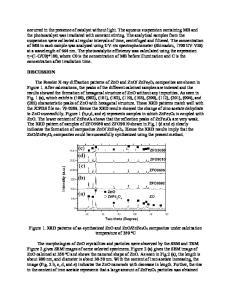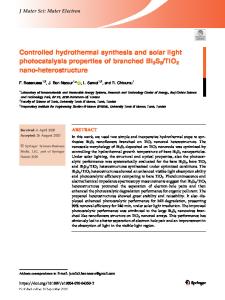Mechanochemical Synthesis, Structural Characterization and Visible Light Photocatalysis of TiO 2 /ZnFe 2 O 4 Nnanocompos
- PDF / 1,554,557 Bytes
- 9 Pages / 612 x 792 pts (letter) Page_size
- 60 Downloads / 474 Views
0900-O09-23.1
Mechanochemical synthesis, structural characterization and visible light photocatalysis of TiO2/ZnFe2O4 nanocomposites Sesha S. Srinivasan, Nikolai Kislov, Jeremy Wade, Matthew T. Smith, Elias K. Stefanakos, Yogi Goswami Clean Energy Research Center, College of Engineering, University of South Florida, Tampa, FL 33620, USA ABSTRACT Nanocomposite heterogeneous semiconductors with suitable energy levels (gaps) are exhibiting excellent photocatalytic properties under visible light irradiation. TiO2/ZnFe2O4 has been selected among different alloys because of (i) its low band gap ~1.9 eV (ii) the nontoxicity of ZnFe2O4 (iii) visible light absorption characteristics of ZnFe2O4 due to its narrow band gap and (iv) not being susceptible to photoanodic corrosion. A mechanochemical synthesis approach using high energy milling is employed to prepare TiO2/ZnFe2O4 under different experimental parameters and conditions. The effects of ball milling and calcination on the photocatalytic behavior of TiO2 and TiO2/ZnFe2O4 have been determined. The as-milled nanocomposite materials are characterized with PXD, SEM and EDS procedures. The photocatalytic activity of TiO2/ZnFe2O4 nanocomposites for the photodegradation of phenol under visible light irradiation has been studied systematically by UV-Vis spectrometer. It is interesting to note a red shift of 0.25 eV in the absorption edge of the ball-milled TiO2 sample when compared to the non ball milled TiO2 photocatalyst. INTRODUCTION Photocatalytic nanomaterials a new kind of eco materials, are widely used for desalination/disinfection and air/water purification applications. Anatase TiO2 is the most widely used semiconductor photocatalyst for an effective decomposition of organic compounds in air and water under UV light irradiation, with wavelength shorter than 387 nm [1, 2]. The major problem is that only about 4% of the solar spectrum falls in this UV range. The efficient use of sunlight becomes an appealing challenge for developing photocatalysts [3]. Some of the potential methods of increasing the visible light photocatalytic activity of TiO2 are ion implantation methods using Cr and V ions [4], synthesization techniques [5], and substitutional doping of non metals such as nitrogen (TiO2-xNx) [6,7], mechanochemical process of TiO2 [8-10]. In recent years, many reports have been published on the enhancement of visible light photocatalysis of TiO2 by nanoparticle coupling with ZnFe2O4 [11-13]. As a low band gap (1.9 eV) semiconductor, ZnFe2O4 has attracted attention as a potential photocatalyst due to its ability to absorb visible wavelengths less than 652 nm. However, the energetically unfavorable conduction band and absorption characteristics of ZnFe2O4 have to be optimized for its efficient use as sensitizer material for coupling with TiO2 photocatalyst.
0900-O09-23.2
In the present paper, we report the systematic study of mechanochemical alloying of ZnFe2O4 with TiO2 powder. Besides, we compare and contrast the effects of ball milling on the photocatalytic behavi
Data Loading...











